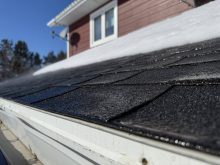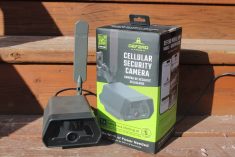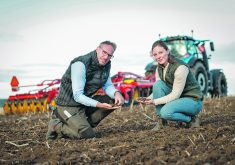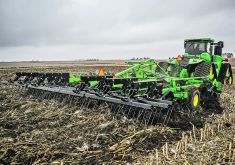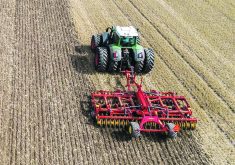Farmers are often the best inventors of farm equipment, often surpassing the major manufacturers on items ranging from better openers to complex digital devices like yield monitors with GPS mapping capacity.
The FarmTRX yield monitor is just such a success story. With a list price of C$1,850, there’s no doubt that FarmTRX is the low-cost alternative to OEM and high-end aftermarket systems. And it gives the same result — quality yield maps.
TRX is able to handle large volumes of field yield data because its only job while combining is to collect data. It does not waste precious time and capacity processing data until the combine stops. That means no more waiting for your yield monitor to feel like it’s ready to work.
Read Also

Farming Smarter receives financial boost from Alberta government for potato research
Farming Smarter near Lethbridge got a boost to its research equipment, thanks to the Alberta government’s increase in funding for research associations.
The TRX is compatible with every combine with a clean grain elevator. The devices are working on combines around the world ranging from a 1969 Deere 105 with 2,000 hours, a 1976 Gleaner L and up to a 2019 Case 9240.
Without special tailoring or modification kits, these farmers are all getting precision ag yield data. To date, about 700 of the monitors have been sold all around the globe.
FarmTRX is the brainchild of Perry Casson, technologist and founding partner of Troo Corp.
Troo is a young global firm specializing in things like aerospace GPS tracking, fleet performance analytics and monitoring helicopters on the other side of the Earth.
Casson also runs the 2,400-acre family farm at Medstead in northwestern Saskatchewan.
In 2015, Casson wanted to conduct variable rate trials. He ran up against a brick wall when told his three mid-1990s combines would have to be replaced or undergo serious investment if he wanted good yield maps. Studying the retro-fit monitors on the market, Casson came to the conclusion that the technology was stuck in the 90s.
That was the push he needed to develop the simple, affordable, easy-to-install, easy-to-use yield mapping system we know as FarmTRX.
Casson’s top priority was to design a yield monitor that would not get in the way of harvest. The system’s only job would be to collect and map yield data. All the manipulation and agronomy work would come later. This approach eliminated the waiting associated with other yield monitors.
His new system does more than collect data. By collaborating with his core company, Troo Corp., Casson gave growers a powerful web mapping platform.
TRX uses a unique mapping capacity that’s on par with Troo’s aerospace technology, says the company’s Mark Hammer. He says it does things others fail to do.
“The emergence of connectivity in smart phones and tablets has enabled us to do things previously considered impossible,” said Hammer in a phone interview.
“We’re not going to build a better in-cab display than an Apple iPad, which cost billions to develop. The huge benefit now is our ability to communicate wirelessly via Bluetooth from our yield monitor to our mobile app, which is working on an android tablet or a iPad or smartphone our customers bring with them into the cab. We send to their existing device.
“The customers already own processing capabilities, visualization capabilities and the visual interface itself. We haven’t had to develop any of those things. That allows us to keep our price point down. The customer already has their own in-cab display. This is a very quickly evolving modern technology that allows you to update whenever you want. If you want a more powerful iPad next year, you know it will work with our system.”
Casson wanted to leverage existing technology and re-purpose it to bring it to a higher standard. For example, the optical sensor is the same as the one used for volumetric sensing on Claas combines since the 1980s. Hammer’s system re-architects what happens after the sensor.
“We designed the system to collapse those things that get in the way of harvest. Nobody wants to take time to re-calibrate when you know you’ve got rain coming the next day and your Number 1 priority is to get the field off. Stopping to re-calibrate the yield monitor isn’t an option. It doesn’t happen. As a result, that field never gets logged.
“We’ve built the data structure to post-calibrate. If you’ve entered the wrong crop type or the wrong header by mistake, we can fix all that later once you’re off the field. We do this because we only capture raw data in the field. Everything else happens after the fact.
“Plus, we automatically do the mapping so our customers don’t even have to think about it. They just go and combine. To the best of my knowledge, nobody else does this.”
Ease of installation and ease of use are two of the benefits, says Hammer. It will work on any combine that has 12-volts and a clean grain elevator with paddles. One person can install the system in less than four hours.
“This works on $2,000 combines and $750,000 combines. The small farmer or farmer with older combines can get highly accurate data that’s on par with any monitor out there. The low investment means they can put money to modernize equipment such as drills or sprayers.”
The FarmTRX has its own GPS, which is independent of any GPS already on the combine. Hammer says there’s a reason. The GPS signal for autosteer is RTK with sub-inch resolution. That level of accuracy may be necessary with seeding equipment but it’s not necessary for combines.
FarmTRX has an accuracy of two to three feet (one metre). When you’re logging yield data, you’re really averaging what comes through the header. Sub-inch resolution isn’t relevant. You’re looking for areas or zones in the field, and three feet is all that’s needed for that task.
“We don’t want to complicate things by trying to tie into numerous different GPS systems. By remaining totally independent of the original combine system, we can build just one universal kit that works on all combines. There’s no need for different setups on different combines.”
The monitor uses the customer’s smart phone or tablet to automatically upload data to the FarmTRX where the program filters the data and builds corrected yield maps, independent of what the combine-mounted monitor is doing.
“Guys get addicted to this, because they see results every day. You download the yield data you’ve gathered that day and take your iPad home. Or if you have a data plan, you can upload it directly to our cloud-based system.
“By the time you get home and had a sandwich, you can log into your web app and all your maps from that day have already been processed and are ready for viewing.
“Now you can export them into any agronomy or precision ag or farm management platform. The whole system is designed so your data is easily accessible for other systems.”
Since launching the original FarmTRX an optional moisture sensor has been added at a cost of $895.
“You don’t absolutely need a moisture sensor for FarmTRX to work, because it’s volume flow detection as opposed to the mass impact plate, which calculates the impact of grain. You need a moisture sensor with that system because you need to determine the weight of the grain hitting the plate.
“We don’t need a moisture sensor because we calibrate by the weight average of a hopper full once. That also means our system isn’t susceptible to moisture fluctuations throughout the day.
“But moisture readings are really handy to have, to tell you if you should be combining or not. We calculate wet and dry yield on the fly so the farmer can decide what to send to the dryer.”






